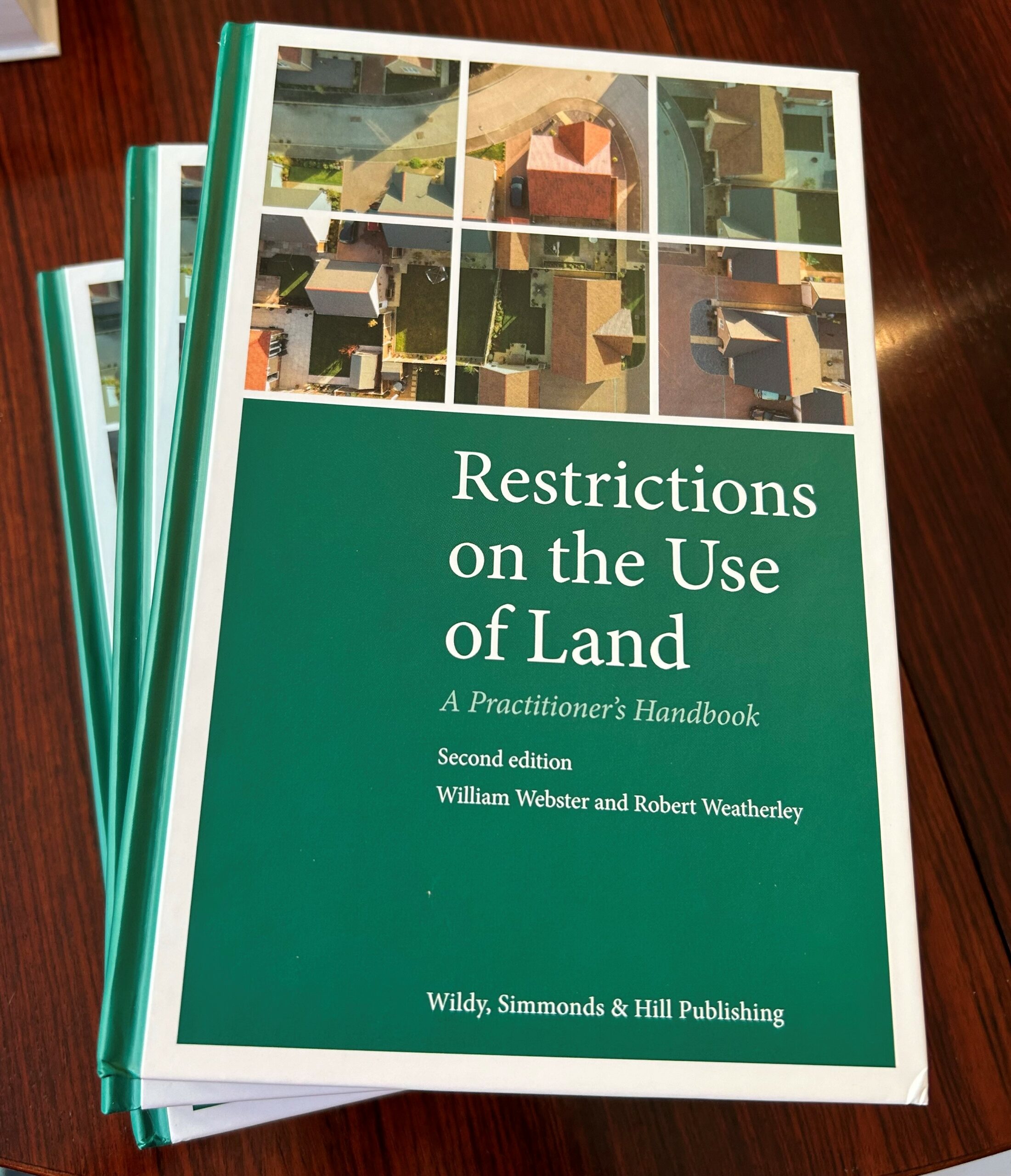Overview
William’s practice comprises traditional land-based Chancery and town and country planning, both in the public and private sectors. He is the author, and also the co-author of text books on planning, easements, the registration of village greens, public rights of way, the listing of assets of community value and restrictive covenants.
Areas of expertise
- Chancery
- Planning
- Land-related professional negligence
- Property
- Registration of land
- Trusts
- Village greens
- Assets of community value
- Public rights of way
- Commercial landlord and tenant
- Coastal defence and shoreline management
- Public law issues involving sales/regeneration/compulsory purchase/appropriation/overriding restrictions on land
Publications
"Renewable Energy from Wind and Solar Power: Law and Regulation"
Published by Wildy, Simmonds and Hill in March 2021. The book runs to 310 pages and is the first comprehensive and authoritative coverage of the subject.
Click here to read the author's preface.
The book includes a foreword by Lord Justice Lindblom who is the senior planning judge in the Court of Appeal.
Foreword
William Webster has taken on, and performed, a formidable task. In describing and explaining the complex framework of regulation for electricity generation by the two principal sources of renewable energy in this country - solar and wind power - and in presenting a vast amount of law, policy and decision-making, he has filled an expanding gap in the literature on environmental and energy law. Indeed, he has produced the first comprehensive, and authoritative coverage of the subject in a legal textbook.
Rightly, the book places its examination of the relevant law and policy in the wider context of the United Kingdom's efforts to reduce reliance on fossil fuels, the legally binding targets for greenhouse gas emissions in the Climate Change Act 2008, the international obligations under the Paris Agreement of 2015, the IPCC's "Special Report on Global Warming of 1.5C" of October 2018, and the reports of the Committee on Climate Change in 2018 and 2019.
The book explores the arrangements for the approval of wind and solar energy projects in the planning legislation and the process of gaining consent under section 36 of the Electricity Act 1989. It connects that discussion to the legislation regimes for the protection of the environment, including the legislation for environmental impact assessment, with a particular focus on habitats and the historic environment. It illuminates the law on nationally significant infrastructure projects. It brings together the national policy and guidance bearing on wind and solar energy projects. And it devotes full chapters specifically to the development of wind farms, both onshore and offshore, and to the development of solar energy. All of this is lucid and thorough.
A feature of the book likely to be welcomed by practitioners is the series of case studies in chapters 8 and 10, which analyse recent decisions of the courts and of the Secretary of State, or an inspector and reporter, and draw out the salient principles - for example, on wind power or solar power development proposed in the Green Belt; or affecting important landscape or seascape, or a heritage asset or its setting; or biodiversity; or likely to harm the living conditions of local residents; or offering "community benefits"; or of a scale requiring a development consent order, with a wide range of implications for the local environment, and requiring powers for the compulsory acquisition of land. Here again the approach is both practical and meticulous.
William Webster's experience as a practitioner in this area of the law, the case he has taken in organising his material and the clarity of his text will, I am sure, bring this book the success it deserves.
The Right Honourable Lord Justice Lindblom
Royal Courts of Justice
August 2020
Click here to read a review of the book by Dr Ashley Bowes, Editor of the Journal of Planning and Environment Law.
Planning Law: A Practitioner’s Handbook
This book runs to 766 pages and includes a foreword by Lord Justice Lindblom. The book was published by Wildy, Simmonds and Hill in February 2019. It covers a wide range of planning topics and planning-related topics within a single volume.
Lord Justice Lindblom’s foreword to this book is as follows:
Foreword
In an area of the law that is constantly changing, and constantly growing in complexity, a new text book will always be welcome – the more so if it is thorough, reliable and insightful. This one undoubtedly is.
The challenges facing an author who aims to reflect recent changes to the legislative regime for planning, and to record the work of the courts in developing and clarifying the law, are formidable. Gathering the various themes into a clear and usable guide is no easy task.
William Webster has managed to cover his subject fully, with a sure grasp of the law, and a facility to point out the salient principles where they occur. His discussion of the principles governing development control and plan-making, the interpretation of national planning policy, planning conditions and obligations, environmental impact assessment, the enforcement of planning control, listed buildings and conservation areas, town and village greens, the lawfulness of planning decisions, and a host of other topics, is thoughtful, lucid and comprehensive. The analysis is sound, and amply supported by relevant case law.
Practitioners looking for answers to the questions they meet in advising clients on the law, and when preparing argument in proceedings before the courts, can expect to find answers here. For judges too, both in the Planning Court and elsewhere, the text will be enlightening.
I wish this excellent book the success it deserves.
The Right Honourable Lord Justice Lindblom
Royal Courts of Justice
Click here for more information about the contents of the book on the publisher's website.
Click here to read a review of the book in Thomson Reuters by Dr Ashley Bowes, Editor of the Journal of Planning & Environment Law.
Topics covered include:
- Assets of community value
- Town and village greens
- Public rights of way
- Gypsies and travellers (policy and enforcement)
It is written for busy planning practitioners in the private and public sectors. The book is a single up-to-date reference book and contains a substantial body of footnotes covering the material primary and secondary legislation and case law.
Restrictions on the Use of Land
This book was published by Wildy, Simmonds and Hill Publishing in November 2016 and extends to nearly 600 pages. It was co-authored with a colleague at 3PB (Robert Weatherley). The book contains sections on easements, village greens, public rights of way, restrictive covenants, assets of community value and elements of planning law. The authors are indebted to Lord Neuberger, then President of the Supreme Court, for his helpful foreword:
‘A book which analyses and explains this complex law (governing the use of land) in an authoritative, up-to-date, practical and clear way is to be warmly welcomed. William Webster and Robert Weatherley deserve warm thanks for having produced such a timely book.’
Direct Access
William is qualified to accept instructions directly from members of the public and professional clients under the Direct Access Scheme.
Expertise
-
Add this expertise to your shortlist
Notable examples of recent work in the planning/public law sector:
- JR challenge claiming misapplication of local/national policies and unlawfulness in decision-making in a case involving the provision of replacement facilities arising from the closure of a football stadium sited in an area targeted for regeneration.
- Acting for a local authority in the case of a disputed land option which did not run with the land and loss of chance damages against original covenantor.
- Acting for a football club at a public planning inquiry involving equivalence of proposed replacement facilities.
- Acting for a football club on an appeal against listing of ground as an asset of community value.
- Advice on regulatory functions in the case of coastal protection works and the delivery of Shoreline Management Plan policies.
- Acting for local highway on judicial review of modification order.
- Acting for a local authority on claims for compensation arising out of highway works.
- A challenging cross-boundary planning appeal in the Midlands involving a proposal for enabling development to fund enhancements to the natural environment, an appraisal of biodiversity net gain using the DEFRA Biodiversity Metric Calculation Tool, and the largest spread of Japanese Knotweed experts had ever seen.
- Planning enforcement and committal proceedings in multiple cases involving the gypsy traveller community.
- A proposal within the site of a Scheduled Monument (buried Roman artefacts).
- Planning conditions limiting the occupancy of new or converted dwellings to local inhabitants (William has also lectured on this topic).
- Planning obligations which concerned developer delivery of school sites.
- Advising a neighbouring owner in the case of a proposed 2-storey leisure centre spa building (in the grounds of a Grade 2 listed hotel complex in a conservation area) involving significant impacts on habitats and the prospect of unacceptable light and noise pollution.
- Advice on tall buildings in Birmingham and London involving issues of excessive height and massing and adverse impact on the townscape, including the setting of heritage assets and harm to the historic environment (historic canals).
- Advice on assessments made under the Habitats Regulations’ along with disputed mitigation contributions and design issues affecting a 100 plus residential development close to European sites.
- Appeal involving village infilling exception on a site in the Green Belt.
- Control of advertisements. Advice was sought on the likelihood of consent to the siting of an elevated digital display unit on a building overlooking a large roundabout having five exists and four entrances.
- Planning enforcement – unlawful subdivision: the issue was whether children under the age of 18 counted as ‘residents’ for the purposes of a Class 4 use (Paramaguru v Ealing LBC [2018] EWHC 373 (Admin)).
- Disputed claim to standing in Planning Court where neither appellant had made objections during the appeal process and merely lived in neighbouring properties (Crawford-Brunt v Secretary of State for Communities and Local Government [2015] EWHC 3580 (Admin).
- Successful application to discharge an order made under section 215 of the TCPA 1990 (under which an authority may take steps requiring land to be cleaned up when its condition adversely affects the amenity of an area).
- Acting in high value litigation between operators involved in the management, disposal and recycling of household waste.
- Instructed by Surrey County Council to act as their non-statutory inspector in R (NHS) Property Services Ltd) v Surrey County Council [2019] UKSC 58, a case which ultimately went to the Supreme Court where William’s recommendation to the registration authority on the statutory incompatibility objection was upheld, as was his recommendation that the application to register be dismissed.
- William also appeared as junior counsel in the Supreme Court in Taylor v Betterment Properties (Weymouth) Ltd [2014] UKSC 6 (a village green case), now the leading case on non-peaceable use (William also speaks regularly on village greens and highways).
- As an Inspector, William recently conducted the first remote village green inquiry in England and Wales for Wiltshire Council (land at Hilperton near Trowbridge).
- Again as an Inspector, William also conducted Village Green Inquiries for Wiltshire Council (land at Semington near Melksham) and for Staffordshire County Council (land at Heath Hayes).
- William regularly advises on public right of way (PROW) disputes and also appears for landowners at DMMO confirmation inquiries in the case of opposed modification orders.
- William is currently acting for Staffordshire County Council on a landowner’s application for judicial review in the case of a challenge to an order made by the surveying authority to add a PROW to the Definitive Map despite the fact that the order has not yet been confirmed by the Secretary of State as an opposed order. The issue is whether, as a matter of fact and law, the landowner is in a position to pre-empt the statutory confirmation process.
- Acting for Bournemouth, Christchurch and Poole Council in a disputed confirmation appeal at a DMMO public inquiry where there were objections to the closure and diversion to a right of way, including in relation to disability discrimination (the new path had steps). The appeal outcome was reported.
- William also regularly advises on the law and practice of assets of community value (ACV) (introduced in the Localism Act 2011). He acted for the listing authorities on the listing of the football stadia of Old Trafford and Anfield. He has also appeared at ACV review hearings where it is possible to rescind a listing prior to a challenge being taken to the First-tier Tribunal. Local listing is now a consideration of some weight in the planning process. William has recently been involved in challenges affecting the listing of pubs in Somerset and Gravesend (both Grade II listed buildings in conservation areas). William is also acting for Basingstoke Town Community Football Club in the case of the landowner’s pending appeal in the First-tier Tribunal in the case of their former ground at Basingstoke which has been listed as an ACV.
- Advising a local authority on their powers to override easements and restrictive covenants under the Housing and Planning Act 1996 (ss.203-4) and generally in the case of the exercise of statutory powers, including advice on the authority’s power of appropriation and sale where land is affected by third party rights.
- Advice in relation to the carrying out of coastal defence works by a coastal erosion management authority.
- Acting for Surrey County Council in its capacity as Commons Registration Authority on an application to remove land from the Register of Common Land (application involved disputed curtilage of a substantial Grade II listed property set in an AONB).
Other recent private law land disputes:
- TOLATA dispute and accounts involving ownership of a traveller site.
- Acting for servient owner in an action for an injunction and damages arising from the use of a right of way by a garden centre for the sale of goods outside the range of goods allowed to be sold within the scope of the permitted private right of way.
- Boundary dispute in the countryside involving the development of land claimed to be within the curtilage of a neighbouring SSSI.
- Advice on right to light loss and assessment of quantum arising from overshadowing commercial development in an historic Bath street.
- Advice on breach of the covenant for quiet enjoyment/derogation from grant in the case of the acts or omissions of a commercial landlord.
- Advice on nuisance arising from the shared use of a right of way (business) and the recovery of sums spent on improvements.
- Tenant’s claim to set aside Tomlin Order (involving a business tenancy) which lacked prudent safeguards, along with an associated trespass to goods claim involving the unlawful removal of externally located refrigeration plant which resulted in severe financial loss to the client’s business.
- Claimed negligence against a planning consultant arising from failed applications for a prior approval planning permission for a Class O use.
- Advising Parish Council on the recovery of promised community benefits arising from the development of a solar farm.
- Advising owner of a two-storey training venue for boxing and other community uses in relation to claimed trespass and serious nuisance arising from adjoining infill development.
- Advising multiple tenants of long leases in a large building in relation to claimed long-standing breaches of landlord’s repairing covenants, including subsidence damage. Claim involves specific performance of repairing covenants and differing claims for damages for breach of the covenants for repair/loss of quiet enjoyment (including for loss of assessed rental value).
- Multiple cases involving land registration issues including, in one case, where a restriction had not even been registered against the holder of the unregistered title and, in another, where the deed containing the restrictions had not even been executed by the original covenantor.
- Multiple cases involving advice, the drafting of applications and a hearing in the Upper Tribunal for orders for discharge or modification of restrictive covenants.
-
Add this expertise to your shortlist
William’s experience in his field of chancery work allows him to examine, advise upon and conduct claims where professional negligence issues arise. His expertise in property issues lead him to be called in where there may have been negligence by professional advisers such as counsel, solicitors, surveyors or valuers.
-
-
Journal of Planning and Environment Law publishes a superb review of Webster and Weatherley’s “Restrictions on the Use of Land”
28th Jul 2017
Journal of Planning and Environment Law publishes a superb review of Webster and Weatherley’s “Restrictions on the Use of Land”.
In a review authored by Dr Ashley Bowes, the Journal of Planning and Environment Law has positively commented on “Restrictions on the Use of Land”, William Webster and Robert Weatherley’s planning law reference book.
Click below to read the review.
Published by Wildy, Simmonds & Hill the book covers the law and practice in a number of fields which impact the use of land and there is considerable focus on remedies for the infringement of rights in, on or over land. The areas covered include: easements, town and village greens, public rights of way, restrictive covenants, assets of community value and elements of planning law.
View Article
-
Housing White Paper
9th Feb 2017
3PB Planning Barristers William Webster and Graeme Sampson summarise and analyse the government's Housing White Paper.
View Article
-
William Webster of 3PB Barristers is well known for his expertise in various areas of planning law, including village greens, assets of community value and public rights of way. He frequently acts for local authorities, landowners and developers.
Strengths: "He is a focused barrister.”
“William is always supportive.”
Chambers UK 2024/Planning/Western Bar/Band 1
Chambers UK 2023/Planning/Western Bar/Band 1
'William is very experienced and knowledgeable in this area of law. He has good management skills in a public inquiry setting and communicates readily and clearly with all parties. His reports and recommendations are also extremely detailed and thorough.'
Legal 500 2024/Planning and Environment/Leading Juniors/Western Circuit - Ranked: Tier 1
‘William is highly knowledgeable about planning law, and he focuses on the cases' key points. His communication with judges is both clear and persuasive.'
Legal 500 2023/Planning and Environment/Leading Juniors/Western Circuit - Ranked: Tier 1
Strengths: "He is very easy to work with and accessible, and has a wealth of experience."
Chambers UK 2022/Planning/Western Bar
‘William is a recognised expert in town and country planning. He is efficient, knowledgeable and thorough.’
Legal 500 2022/Planning and Environment/Leading Juniors/Western Circuit
Strengths: "William is approachable, clear in his advice and puts the client at ease due to his thorough comprehension of complicated issues."
Chambers UK 2021/Planning/Western Bar
‘His chain of thought is clear, precise and the advice covers all aspects that a client may wish to cover. William is strong in his area and also considers costs efficiency for the client without prejudicing the client's position.’
"Of particular note, William Webster is a specialist in the law of village greens having sat as an inspector at numerous non-statutory inquiries and has also appeared in the Court of Appeal and Supreme Court in leading village green cases. 'In a public inquiry setting, he has the ability to explain the issues to the applicants who have no legal knowledge and background in a way that avoids being patronising and conveys the meaning in a readily understandable way,' said one solicitor."
Legal 500 2021/Planning and environment
‘He has superb planning knowledge.’
Legal 500 2020/Construction/Planning and Environment
'An expert in land law.'
Legal 500 2018/19 Construction/Planning and Environment
‘A feisty and forceful advocate.’
Legal 500 UK 2017/ Construction/Planning and Environment
"A careful lawyer and an effective advocate."
Legal 500 UK 2016 /Construction/Planning and Environment
Recommendation from an instructing solicitor:
"Verdict on William Webster today – very good indeed, 120/10 thanks.".
"I cannot thank you enough for the introduction to William Webster. Both my clients and myself were more than impressed with not only his hard work, the way in which he was able to absorb, in such a short time, all the papers in an extremely complex matter in which both my and his predecessors had made elementary mistakes.
His “bedside manner” with his lay clients was second to none. His conduct in court with both his opponent and the judge was exemplary.
Chris, once again, you have helped me out of a difficult situation for which I will ever be grateful. If only there were more clerks like you who are willing to go that extra mile.
I have recommended 3PB to all in this firm as well as the criminal practice, to which I am a consultant and my daughter’s new firm in London.
Rest assured you will be my 1st port of call for all my southern work and Mr Webster in particular for ALL my property work."
Expand recommendations





